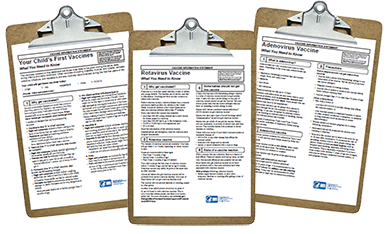Key points
- A Vaccine Information Statement (VIS) allows vaccine recipients/legal representatives to understand vaccine benefits and risks.
- Learn the different methods and places VISs are provided to patients.

What's a VIS?
A VIS or Vaccine Information Statement is a document, produced by CDC, that informs vaccine recipients – or their parents or legal representatives – about the benefits and risks of a vaccine they are receiving.
Read about the evolution and history of Vaccine Information Statements.
VISs are required by law
All vaccine providers, public or private, are required by the National Vaccine Childhood Injury Act (NCVIA – 42 U.S.C. § 300aa-26) to give the appropriate VIS to the patient (or parent or legal representative) prior to every dose of specific vaccines.
The appropriate VIS must be given prior to the vaccination, and must be given prior to each dose of a multi-dose series. It must be given regardless of the age of the recipient.
Ways to give a VIS
- Paper copies of the VIS can be printed and given to patients prior to vaccination.
- Permanent, laminated office copies may be given to patients to read prior to vaccination.
- Patients may view VISs on a computer monitor or other video display.
- Patients may read the VIS on their phone or other digital device by downloading the pdf file from CDC's website.
- Patients may be given a copy of a VIS during a prior visit, or told how to access it through the internet, so they can read it in advance. These patients must still be offered a copy to read during the immunization visit, as a reminder.
Patients must still be offered a copy of the VIS to take away following the vaccination. The patient may decline.
Where to get VISs
CDC maintains a current English language VIS for each vaccine. You and your patients can
- View and display the web page
- Download and print the PDF file
- Import the RTF (text) file into an electronic system
- View on a smartphone, tablet or other web-accessible mobile device
Translations
VISs have been translated into about 40 languages. These can be found on the website of CDC's partner, immunize.org. Not every VIS has been translated into every language.
Other provider responsibilities
In addition to distributing VISs, as described above, providers are required to record specific information in the patient's medical record (which can include an electronic medical record), or in a permanent office log:
- The edition date of the VIS (found on the back at the right bottom corner).
- The date the VIS is provided (i.e., the date of the visit when the vaccine is administered).
- The office address and name and title of the person who administers the vaccine.
- The date the vaccine is administered.
- The vaccine manufacturer and lot number.
Providers may add the name, address, and contact information of their practice to an existing VIS, but may not make any substantive changes.
In addition to providing a VIS to patients to read, you can
- read it to them,
- provide a videotaped version,
- give additional printed material,
or help recipients understand the disease and vaccine in any other way.
Always offer the patient an opportunity to ask questions about the vaccine you are giving them.
VISs for these vaccines are required under the NCVIA, as of March 2013:
- Diphtheria, tetanus and pertussis containing vaccines (DTaP, DT, Td, and Tdap)
- Haemophilus influenzae type b (Hib)
- Hepatitis A
- Hepatitis B
- Human Papillomavirus (HPV)
- Influenza (both Inactivated and Live, Intranasal vaccines)
- MMR
- MMRV
- Meningococcal
- Pneumococcal Conjugate (PCV)
- Polio
- Rotavirus
- Varicella
VISs also exist for vaccines that are not covered by the NCVIA. CDC encourages healthcare providers to use these whenever they give one of these vaccines, but they must be used when the vaccine is purchased under CDC contract. The legal basis for this is not the NCVIA, but a "Duty to Warn" clause in CDC's vaccine contracts.
These vaccines are:
- Adenovirus (Military Use Only)
- Anthrax
- Cholera
- COVID-19
- Dengue
- Japanese Encephalitis
- Pneumococcal Polysaccharide
- Rabies
- Respiratory Syncytial Virus (RSV)
- Shingles
- Smallpox/Monkeypox
- Tick-borne Encephalitis (TBE)
- Typhoid
- Yellow Fever
